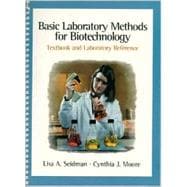
| UNIT I: INTRODUCTION TO THE BIOTECHNOLOGY WORKPLACE | 1 | (44) | |||
|
7 | (12) | |||
|
19 | (14) | |||
|
33 | (12) | |||
| UNIT II: PRODUCT QUALITY AND BIOTECHNOLOGY | 45 | (52) | |||
|
51 | (8) | |||
|
59 | (16) | |||
|
75 | (10) | |||
|
85 | (12) | |||
| UNIT III: MATH IN THE BIOTECHNOLOGY LABORATORY: AN OVERVIEW | 97 | (82) | |||
|
103 | (16) | |||
|
119 | (32) | |||
|
151 | (28) | |||
| UNIT IV: DATA IN THE LABORATORY | 179 | (48) | |||
|
183 | (28) | |||
|
211 | (16) | |||
| UNIT V: LABORATORY MEASUREMENTS | 227 | (214) | |||
|
229 | (28) | |||
|
257 | (24) | |||
|
281 | (20) | |||
|
301 | (24) | |||
|
325 | (16) | |||
|
341 | (30) | |||
|
371 | (30) | |||
|
401 | (40) | |||
| UNIT VI: LABORATORY SOLUTIONS | 441 | (94) | |||
|
449 | (16) | |||
|
465 | (18) | |||
|
483 | (26) | |||
|
509 | (26) | |||
| UNIT VII: BASIC SEPARATION METHODS | 535 | (58) | |||
|
537 | (10) | |||
|
547 | (26) | |||
|
573 | (20) | |||
| UNIT VIII: SAFETY IN THE LABORATORY | 593 | (70) | |||
|
595 | (18) | |||
|
613 | (26) | |||
|
639 | (24) | |||
| UNIT IX: COMPUTERS IN THE LABORATORY | 663 | (64) | |||
|
673 | (22) | |||
|
695 | (20) | |||
|
715 | (12) | |||
| Index | 727 |
The New copy of this book will include any supplemental materials advertised. Please check the title of the book to determine if it should include any access cards, study guides, lab manuals, CDs, etc.
The Used, Rental and eBook copies of this book are not guaranteed to include any supplemental materials. Typically, only the book itself is included. This is true even if the title states it includes any access cards, study guides, lab manuals, CDs, etc.